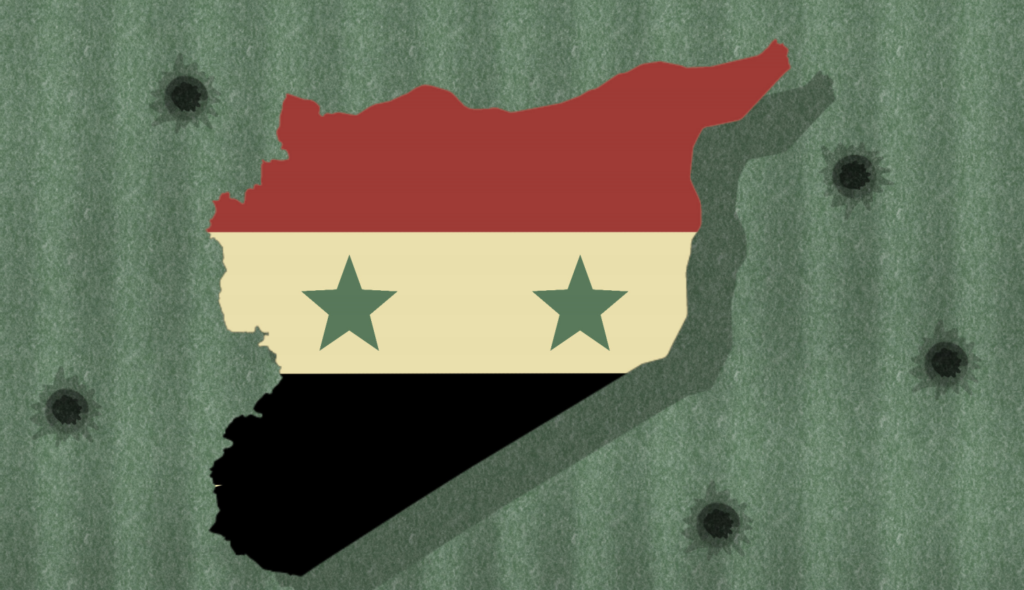
Graphic by Yujin Kim/The Choate News
Sarfarna Ala Europa, a song every Syrian child knows by heart, is rhythmic, up-beat, and pop-inspired. The lyrics, however, depict the suffering and fear of the weary refugee. One doesn’t need to know Arabic to understand the song’s meaning, nor the effect of the decade-long Syrian conflict on its people. What began ten years ago as an internal struggle, has evolved into an inter-national chess match — different players with varying strategies using the Syrian people as pawns.
On May 26, the current Syrian President Bashar al-Assad will attempt to secure another term in office; this will be his second election since March 2011, when pro-democracy demonstrators took to the streets of Daraa, Syria in an attempt to end 40 years of repressive rule. While the Arab Spring uprisings led to government collapses in Egypt and Libya, Syria’s President Bashar Assad refused to capitulate, thus beginning a protracted civil war between the insurrectionists and the al-Assad-led Syrian regime.
Over the past ten years, support from the Sunni in the Syrian cities of Aleppo and Damascusbolstered President al-Assad’sbrutal hold over Syria. However, the neighboring countries, world powers, jihadists, and the Islamic State (ISIS) have been the ones fueling the war — with al-Assad, himself, being the only beneficiary. The U.S. involvement in the region is primarily focused on ISISwhich formed as a subgroup of AlQaeda but broke away following internal disagreements. U.S. allies, however, have other non-ISIS priorities. Each for their own reasons, Turkey, Saudi Arabia, Jordan, and the US. back the insurgents, while Iran and Russia support the As-sad regime, resulting in numerous proxy wars fought on Syrian soil: Israel v. Iran; Turkey v. Kurds; US v. Turkey; Russia v. US; and Secularists (Russia/US/UAE) v. Islamists (Turkey/Iran/Qatar).
And what of U.S. involvement? In June 2013, the U.N. reported that approximately 90,000 people had been killed since those initial protests. In reaction to Presidental-Assad’s 2013 use of chemical weapons against his own people, President Barack Obama signed an order authorizing the C.I.A. to train the Syrian rebel forces. By August 2015, the number of deaths reached 250,000. In 2017, al-As-sad, again, used nerve gas against the rebel-held town of KhanSheikhoun. In response, the newU.S. president, Donald J. Trump P’00. fired dozens of cruise missiles at Syrian Air Force bases. Today, an estimated 500,000 people have been killed or are missing. Clearly, the U.S. response to date — military strikes or threats of strikes —has been ineffective.
WorldVision, an international Evangelical Christian humanitarian organization, estimates that there are 5.6 million Syrian refugees — the majority having escaped to Turkey, Lebanon, Jordan, Iraq, and Egypt — and6.1 million people displaced within Syria. People who are virtually trapped in their war-torn country are witnessing daily horrors and struggling to stay alive in a country with an annihilated infrastructure and devastated economy. At last count, over 11million people are in need of humanitarian aid and roughly half of those are children. No longer able to attend school, Syrian children have fallen behind in their studies and experienced delayed developmental growth. Many are drafted into the conflict or captured trying to find a safe harbor.
The decade has seen the destruction of Syrian hospitals, schools, and necessary civilian infrastructure such as water systems and utilities. The ability of the Syrian people to locate and procure the most basic of necessities — food and clean water — has become tenuous at best. To date, 80% of Syrians are living on less than $1.90 a day. The challenges of poverty and unemployment have only been exacerbated by the Covid-19 pandemic where overcrowded refugee camps make it impossible to practice safe distancing and good hygiene. Aid groups like the UN Refugee Agency have been providing shelter, supplies, and medical care to those who have been displaced, as well as trying to support the Syrian children with educational instruction and mental health support.
In September 2013, two years after the start of the conflict, Antonio Guterres, the United Nations High Commissioner for Refugees, said, “Syria has become the great tragedy of this century — a disgraceful humanitarian calamity with suffering and displacement unparalleled in recent history.” Ten years later, I am reminded of the quote, “The only thing worse than a tragedy is when you can’t do anything about it.”
Recently, Mr. Guterres spoke of our collective responsibility to end this war and has raised and pledged another $6.4 billion to support those affected. As for U.S. responsibility? The U.S. must acknowledge “there is no military solution in Syria,” and throw its full support behind the U.N. to use international law and diplomacy to settle this conflict. As long as foreign power said the two Syrian factions, there is no end in sight to this war.
To support Syrians, consider donating to the Syrian American Medical Society (SAMS) — a healthcare relief agency that works to treat the sick and injured.




